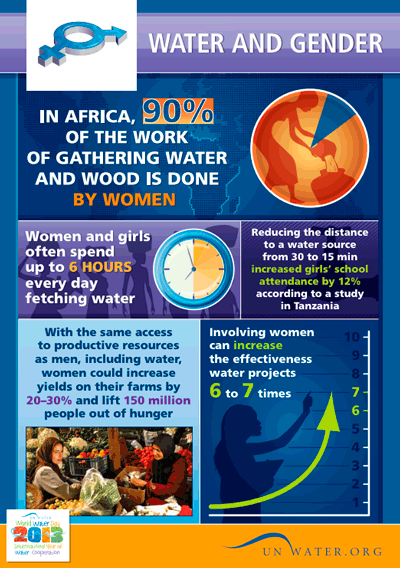- ON THE DECADE
- THE DECADE'S CAMPAIGN
- REPORTING ON PROGRESS
- THE DECADE'S PROGRAMMES
- FOCUS AREAS
-
- Access to sanitation
- Financing water
- Gender and water
- Human right to water
- Integrated Water Resources Management
- Transboundary waters
- Water and cities
- Water and energy
- Water and food security
- Water and sustainable development
- Water and the green economy
- Water cooperation
- Water quality
- Water scarcity
- FOCUS REGIONS
- RESOURCES FOR
- UN e-RESOURCES
Gender and water
Gender refers to the different roles, rights, and responsibilities of men and women and the relations between them. Gender does not simply refer to women or men, but to the way their qualities, behaviours, and identities are determined through the process of socialization.
Gender is generally associated with unequal power and access to choices and resources. The different positions of women and men are influenced by historical, religious, economic and cultural realities. These relations and responsibilities can and do change over time.
It has become increasingly accepted that women should play an important role in water management and that this role could be enhanced through the strategy of gender mainstreaming.
The importance of involving both women and men in the management of water and sanitation and access-related questions has been recognized at the global level, starting from the 1977 United Nations Water Conference at Mar del Plata, the International Drinking Water and Sanitation Decade (1981-90) and the International Conference on Water and the Environment in Dublin (January 1992), which explicitly recognizes the central role of women in the provision, management and safeguarding of water. Reference is also made to the involvement of women in water management in Agenda 21 (chapter 18) and the Johannesburg Plan of Implementation. Moreover, the resolution establishing the International Decade for Action, 'Water for Life' (2005-2015), calls for women's participation and involvement in water-related development efforts.
The differences and inequalities between women and men influence how individuals respond to changes in water resources management. Understanding gender roles, relations, and inequalities can help explain the choices people make and their different options. Involving both women and men in integrated water resources initiatives can increase project effectiveness and efficiency.
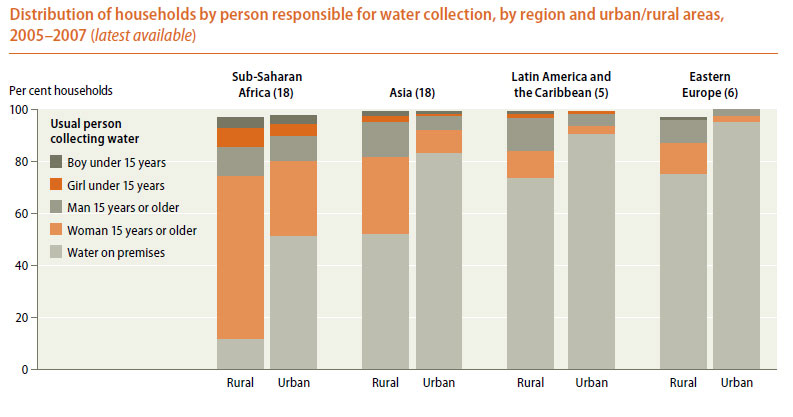
Source: (The) World's Women 2010. Trends and Statistics. UNDESA, 2010
Without specific attention to gender issues and initiatives, projects can reinforce inequalities between women and men and even increase gender disparities.
Sources:
- Resource guide: Mainstreaming gender in water. United Nations Development Programme (UNDP), 2006
- Gender, water and sanitation. Policy brief. Interagency Task Force on Gender and Water, 2006
Gender, water and the MDGs
- Targets, such as those in the Millennium Development Goals relating to water, are unlikely to be achieved unless gender perspectives are integrated into planning and implementation activities
- Reduced time, health, and care-giving burdens from improved water services give women more time for productive endeavours, adult education, empowerment activities, leisure
- Convenient access to water and sanitation facilities increase privacy and reduce risk to women and girls of sexual harassment/assault while gathering water
- Higher rates of child survival are a precursor to the demographic transition to lower fertility rates; having fewer children reduces women's household responsibilities and increases their opportunities for personal development.
Sources:
- Women 2000 and beyond. Women and Water. UNDESA, 2005.
- Health, Dignity and Development: What will it take? Millennium Project Task Force on Water and Sanitation, 2005.
What is "gender mainstreaming"?
Gender mainstreaming is the process of assessing the implications for women and men of any planned action, including legislation, policies or programmes, in all areas and at all levels. It is a strategy for making women's as well as men's concerns and experiences an integral dimension of the design, implementation, monitoring and evaluation of policies and programmes in all spheres so that women and men benefit equally.
Source: Resource guide: Mainstreaming gender in water. United Nations Development Programme (UNDP), 2006
Did you know?
Fetching water is part of the gender inequality
- In rural Benin, girls ages 6-14 spend an average of one hour a day collecting water compared with 25 minutes for their brothers.
- In Malawi, there are large variations in the amount of time allocated for water collection based on seasonal factors, but women consistently spend four to five times longer than men on this task.
- In Tanzania, a survey found school attendance to be 12 per cent higher for girls in homes located 15 minutes or less from a water source than in homes one hour or more away. Attendance rates for boys appeared to be far less affected by distance from water sources.
- In 12% of households children carry the main responsibility for collecting water, with girls under 15 years of age being twice as likely to carry this responsibility as boys under the age of 15 years.
- Research in sub-Saharan Africa suggests that women and girls in low-income countries spend 40 billion hours a year collecting water—the equivalent of a year’s worth of labour by the entire Work force in France.
- In Africa, 90% of the work of gathering water and wood, for the household and for food preparation, is done by women. Providing access to clean water close to the home can dramatically reduce women’s workloads, and free up time for other economic activities. For their daughters, this time can be used to attend school.
Sanitation is one of the major challenges faced in overcoming gender inequalities
- Inadequate access to safe, hygienic and private sanitation facilities is a source of shame, physical discomfort and insecurity for millions of women across the world. Cultural norms frequently make it unacceptable for women to be seen defecating—forcing many women to leave home before dawn or after nightfall to maintain privacy.
- When women have to wait until dark to defecate and urinate in the open they tend to drink less during the day, resulting in all kinds of health problems such as urinary tract infections.
- One problem that has been observed is that the latrine designs, especially for primary and secondary schools, are mainly prepared by male masons. The tendency therefore has been to construct latrines which are not sensitive to the special needs of girls. This has resulted in girls staying away from schools when they are menstruating, even when their schools have latrines. In the case of small boys too, the urinals are often too high. Moreover, it is important that separate sanitary latrines are constructed for boys, in order to prevent boys from taking over the latrines that are meant for the girls.
Sources:
- Human Development Report 2006. Beyond scarcity: Power, poverty and the global water crisis. United Nations Development Programme (UNDP), 2006.
- Progress on sanitation and drinking water: 2010 update. WHO/UNICEF Joint Monitoring Programme (JMP), 2010.
- Mainstreaming Gender in Water Management. Resource Guide. United Nations Development Programme (UNDP), Gender and Water Alliance (GWA), 2006.
UN initiatives that are helping to raise the issue...
-
UN-Water Task Force on Gender and Water
At the start of the International Year of Freshwater in 2003, the Interagency Network on Women and Gender Equality (IANWGE) established an Inter-agency Gender and Water Task Force. The United Nations Department of Economic and Social Affairs (UNDESA) was invited to serve as Task Manager and a few non-UN entities were welcomed to participate on the Task Force. In 2004, the Task Force became one of UN-Water Task Forces and was requested to take responsibility for the gender component of the International Water for Life Decade, 2005-2015.
To know more
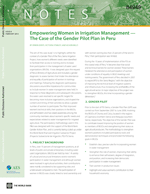 Empowering Women in Irrigation Management - The Case of the Gender Pilot Plan in Peru
Empowering Women in Irrigation Management - The Case of the Gender Pilot Plan in Peru
World Bank. February 2014
This case study aims to highlight, within the context of a Gender Pilot of the Peru Sierra Irrigation Project, how women’s different needs were identified to facilitate their access to training and to increase their participation in the management of water users’ organizations (WUOs). It follows the diagnostic participatory discussions around the importance for communities to include women in water management. In response to these diagnostics and subsequent discussions, the water users resolved to set specific targets for becoming more inclusive organizations, and shaped the content and timing of their activities to allow a greater number of women to participate. The document is divided into 6 titles, which include a background to the project, its achievements benefits and impacts and lessons learned.
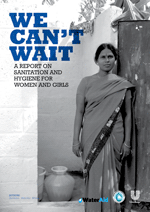 We can’t wait: A report on sanitation and hygiene for women and girls
We can’t wait: A report on sanitation and hygiene for women and girls
United Nations Environment Programme (UNEP), United Nations Entity for Gender Equity and the Empowerment of Women (UN-Women), United Nations Development Programme (UNDP), United Nations Peacebuilding Support Office (PBSO). November 2013
This report highlights the stark consequences for women and girls of the lack of access to toilets and use of good hygiene practices. The report presents information using infographics and visual representation, that makes it applicable to educational forums as well as creating awareness of the impacts on women of poor sanitation across the world. It calls for a concerted effort on a different scale from all levels of government, business and civil society through 5 Chapters: Chapter 1 ‘The Global Sanitation Crisis and Why we can’t wait’; Chapter 2 ‘Why poor sanitation is a women’s issue’; Chapter 3 ‘Girls, sanitation and education – Toilets spell success’; Chapter 4 ‘Menstrual hygiene issues’; and Chapter 5 ‘A crisis far too big to solve alone’ which leads to conclusions and recommendations.
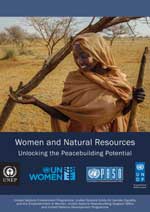 Women and natural resources: Unlocking the peacebuilding potential
Women and natural resources: Unlocking the peacebuilding potential
United Nations Environment Programme (UNEP), United Nations Entity for Gender Equity and the Empowerment of Women (UN-Women), United Nations Development Programme (UNDP), United Nations Peacebuilding Support Office (PBSO). November 2013
This report aims to: (i) improve the understanding of the complex relationship between women and natural resources in conflict-affected settings, and (ii) make the case for pursuing gender equality, women’s empowerment and sustainable natural resource management together in support of peacebuilding. Part 1 provides an analysis of the relationship between women and natural resources in peacebuilding contexts, reviewing key issues across three main categories of resources, including land, renewable and extractive resources. Part 2 discusses entry points for peacebuilding practitioners to address risks and opportunities related to women and natural resource management, focusing on political participation, protection and economic empowerment.
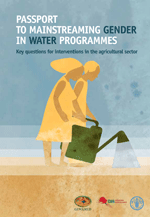 Passport to mainstreaming gender in water programmes. Key questions for interventions in the agricultural sector
Passport to mainstreaming gender in water programmes. Key questions for interventions in the agricultural sector
Food and Agriculture Organization of the United Nations (FAO). June 2013
This booklet was developed for field staff involved in water management projects. It is in pocket format, so that professionals, practitioners and technicians can easily carry it with them. The ultimate beneficiaries are women and men in rural areas who will profit from equal and efficient water distribution, leading to higher yields, improved food security and poverty reduction. The passport focuses on six key issues related to water programmes for agriculture: 1) access to land and water, 2) farming context, 3) multiple use of water, 4) management of irrigation systems, 5) water distribution, irrigation practices and maintenance, and 6) other environmental issues, with specific questions to guide the users in addressing the gender aspects.
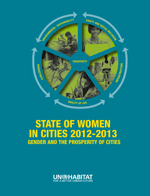 State of Women in Cities 2012-2013. Gender and the Prosperity of Cities
State of Women in Cities 2012-2013. Gender and the Prosperity of Cities
United Nations Human Settlements Programme (UN-Habitat). 2013
The State of Women in Cities 2012/2013 Report focuses on Gender and the Prosperity of Cities. The Report examines the gender dimensions of the defining characteristics of a prosperous city - productivity, infrastructure development, quality of life, equity and social inclusion and environmental sustainability. It provides a conceptual framework for understanding the relationship between gender and prosperity and also reviews policies and institutional framework relevant for mainstreaming gender concerns in cities. Chapter 2.2. "Gender, Infrastructure and Prosperity in Cities" addresses water and sanitation issues.
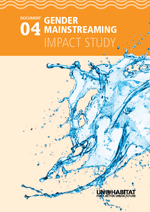 Gender Mainstreaming Impact Study
Gender Mainstreaming Impact Study
United Nations Human Settlements Programme (UN-Habitat). 2011
This impact assessment identifies how the water and sanitation initiatives implemented under the Water Sanitation and Infrastructure Branch of UN-HABITAT, have strategically mainstreamed gender aspects in its various initiatives and to identify achievements and impact, challenges, lessons learned and provide recommendations. The study has looked at global, regional and country activities. The country programmes reviewed are implemented in Ethiopia, Ghana, Kenya and Nigeria in Africa; India, LaoPDR, Nepal and Vietnam in Asia and Nicaragua in the Latin America and Caribbean region.
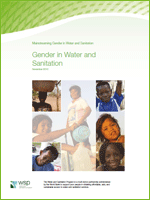 Gender in Water and Sanitation [
Gender in Water and Sanitation [ – 3.41 MB]
– 3.41 MB]
World Bank Water and Sanitation Program (WSP). November 2010
This working paper highlights approaches to redressing gender inequality in the water and sanitation sector. The review is intended for easy reference by sector ministries, donors, citizens, development banks, non-governmental organizations and water and sanitation service providers committed to mainstreaming gender in the sector. Two central features in the review are the illustration of good practices, and checklists. Good practices illustrate where and how a principle described in the text has been applied. They provide a quick pointer for replication, and are intended to guide tailoring the practice to local context. Checklists are provided at the end of each chapter. Presented in a question format, the lists are indicative, to provide practitioners with gender issues and responses to consider at various stages of decision making in the water and sanitation sector.
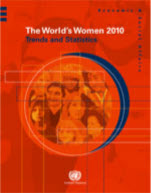 (The) World’s Women 2010. Trends and Statistics
(The) World’s Women 2010. Trends and Statistics
[ – 7.61 MB]
– 7.61 MB]
United Nations Department of Economic and Social Affairs (UNDESA). October 2010
This publication presents and analyses statistics on the status of women in the world and highlights the current situation and changes over time. Chapter 7 examines several environmental aspects with gender-differentiated impacts. The first part of the chapter looks at access to water and firewood, while the second part discusses the effects on health of environmental factors such as indoor smoke from solid fuels, unsafe water and sanitation, and natural disasters.
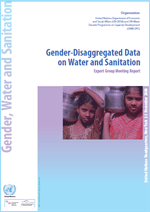 Gender-Disaggregated Data on Water and Sanitation. Expert Group Meeting Report [
Gender-Disaggregated Data on Water and Sanitation. Expert Group Meeting Report [ – 868 KB]
– 868 KB]
United Nations Department of Economic and Social Affairs (UNDESA), UN-Water Decade Programme on Capacity Development (UNW-DPC). 2009
This document presents the main findings from an expert Group meeting convened by UNDESA and UNW-DPC in December 2008. The meeting was intended to support efforts to enhance gender equity in the water and sanitation sectors within the prevailing framework of the MDGs, to explore ways to bridge the gap between conceptual or theoretical comprehension of gender issues and everyday grassroots realities of differential access to and use of water and sanitation, and to assess the state of global gender-disaggregated data. The document presents the current obstacles to developing and using gender-disaggregated data on water and sanitation, and identifies specific information about gender and water/sanitation that should be incorporated into data collection activities. It also provides a summary of data collection needs, indicators and methodologies proposed and a set of recommendations to improve the compilation, evaluation and dissemination of gender-disaggregated data on water and sanitation.
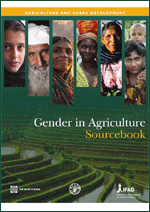 Gender in Agriculture Sourcebook. Module 6 “Gender mainstreaming in agricultural water management”
Gender in Agriculture Sourcebook. Module 6 “Gender mainstreaming in agricultural water management”
[ - 7.4 MB]
- 7.4 MB]
World Bank, Food and Agriculture Organization (FAO), International Fund for Agricultural Development (IFAD). 2009
The purpose of the Sourcebook is to act as a guide for practitioners and technical staff in addressing gender issues and integrating gender-responsive actions in the design and implementation of agricultural projects and programs. Module 6 highlights the need to incorporate gender mainstreaming in agricultural water management. It analyzes the main gender issues that tend to be addressed or solved in the agricultural water management sector. It then presents some good practices learned from specific experiences from Ghana and Gambia. At the end, it introduces some ideas to include gender mainstreaming within the agricultural water management project cycle.
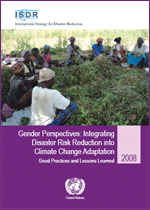 Gender Perspectives: Integrating Disaster Risk Reduction into Climate Change Adaptation. Good Practices and Lessons Learned
[
Gender Perspectives: Integrating Disaster Risk Reduction into Climate Change Adaptation. Good Practices and Lessons Learned
[ – 3.29 MB]
– 3.29 MB]
United Nations International Strategy for Disaster Reduction (UNISDR). 2008
This publication focuses on the nexus between women’s experiences of natural resources management, climate change adaptation and disaster risk reduction, and how they can come together to make whole communities strong and sustainable. It also provides case studies to illustrate ways to support and encourage women’s leadership in water governance and decision-making processes for disaster risk reduction in general. The case studies also point to practical tools for implementing gender equality and mainstreaming gender perspectives.
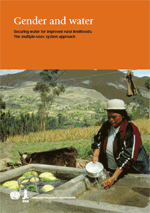 Gender and water. Securing water for improved rural livelihoods: The multiple-uses system approach
Gender and water. Securing water for improved rural livelihoods: The multiple-uses system approach
[ - 2.88 MB]
- 2.88 MB]
International Fund for Agricultural Development (IFAD). 2007
This review analyzes the impact of water-related projects on women, women’s role in managing water resources and the constraints women face in gaining access to water. It presents lessons learned in promoting women’s participation in decision-making for water management using experiences from several IFAD-supported water programmes and projects. It also highlights the innovative activities and catalysts that have helped to address gender issues in water programmes and projects, and offers recommendations on how to improve women’s access to water resources through equitable development and gender mainstreaming.
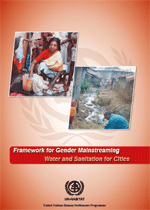 Framework for Gender Mainstreaming: Water and Sanitation for Cities [
Framework for Gender Mainstreaming: Water and Sanitation for Cities [ – 7.4 MB]
– 7.4 MB]
United Nations Human Settlements Programme (UN-HABITAT). 2006
This document presents a gender mainstreaming strategy framework for water and sanitation programmes, projects and policies in cities. The main goal of the strategy is the promotion and strengthening of the participation of women in decision making at the municipal level. The strategy is designed to be used by policy-makers and everyday workers in this field.
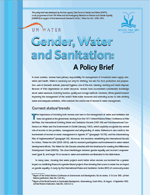 Gender, water and sanitation. Policy brief
[
Gender, water and sanitation. Policy brief
[ - 1.01 MB]
- 1.01 MB]
UN-Water Task Force on Gender and Water. 2006
This booklet analyses the relationship between gender and water-related Millennium Development Goals and suggests specific areas for action to improve gender mainstreaming in water management. As a conclusion, it gives some recommendations to governments, communities and civil society, donors and international organizations.
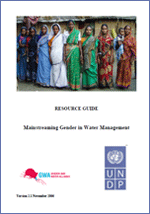 Resource guide: Mainstreaming gender in water management
[
Resource guide: Mainstreaming gender in water management
[ - 1.12 MB]
- 1.12 MB]
United Nations Development Programme (UNDP). 2006
This Guide is an update of the previous resource guide elaborated in 2003 and is a reference document to assist water and gender practitioners and professionals as well as those responsible for gender mainstreaming. The document includes a compilation of newer resources - documents, papers, books, case studies, tools and toolkits- on gender mainstreaming in Integrated Water Resource Management (IRWM); it is meant to support action and further reading and research. The document then links gender and fifteen water sectors trying to highlight the linkages between diversity, gender and water. The fourth chapter addresses a general project cycle from the gender perspective which can be adapted to suit local contexts. Finally, it considers the adoption of a gender policy in water resources management policies and institutions.
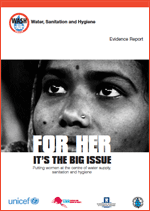 For her it's the big issue. Putting women at the centre of water supply, sanitation and hygiene
[
For her it's the big issue. Putting women at the centre of water supply, sanitation and hygiene
[ - 3 MB]
- 3 MB]
Water Supply and Sanitation Collaborative Council (WSSCC), United Nations Children’s Fund (UNICEF), Gender and Water Alliance (GWA), Water, Engineering and Development Centre (WEDC), Norwegian Ministry of Foreign Affairs. 2006
This report is aimed at supporting policy-makers, sector professionals and practitioners to further strengthen their arguments for involving women at all levels in water supply, sanitation and hygiene (WASH) programmes in order to make them sustainable, successful and beneficial to all. The report is a collection of evidence, brief examples highlighting the effect and benefits of placing women at the core of planning, implementation and operations of WASH programmes. It documents and analyses the many positive contributions that women can make to the achievement of the MDGs, and in promoting human health and sustainable development.
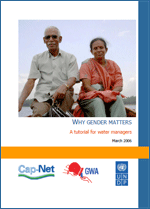 Why gender matters. A tutorial for water managers
Why gender matters. A tutorial for water managers
[ - 1.57 MB]
- 1.57 MB]
United Nations Development Programme (UNDP), Cap-Net, Gender and Water Alliance (GWA). 2006
This tutorial for water managers introduces the gender perspective in water governance. The tutorial is primarily aimed at those people interested in or responsible for managing water resources. It shows how addressing gender will improve efficiency of water use, environmental sustainability, social benefits and equity. The document also presents the benefits of a gender approach at sectoral level and some ideas on how to get these benefits. A selection of useful tools and references is provided at the end of the document.
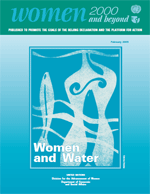 Women 2000 and beyond. Women and Water
[
Women 2000 and beyond. Women and Water
[ – 264 KB]
– 264 KB]
United Nations Department of Economic and Social Affairs (UNDESA). February 2005
This document is intended to raise awareness about the importance of introducing a gender-sensitive approach, learned from the experience, into international water management initiatives. It also promotes new techniques to achieve the inclusion of gender mainstreaming in water governance.
 Women and water: an ethical issue [
Women and water: an ethical issue [ – 294 KB]
– 294 KB]
United Nations Educational, Scientific and Cultural Organization (UNESCO). 2004
After providing an introduction on gender, water and sanitation issues, this document presents different issues related to gender, such as access to water and sanitation, participation and capacity development, privatization and pricing and the protection of water resources.
Gender and water around the world
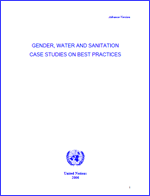 Gender, Water and Sanitation. Case studies on best practices
[
Gender, Water and Sanitation. Case studies on best practices
[ – 2.98 KB]
– 2.98 KB]
United Nations Department of Economic and Social Affairs (UNDESA). 2006
This handbook presents a set of 15 case studies from Asia, Africa, Latin America and the Middle East on gender mainstreaming in the water and sanitation sector. It depicts a series of best practices in securing sustainable safe drinking water and sanitation for communities by engaging both men and women as critical stakeholders. The case studies demonstrate that, at the community level, solutions to clean water and appropriate sanitation are context-specific and that answers to the different interests of men and women can be found through dialogue, innovation, participation and collaboration.
Africa
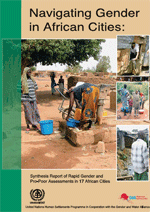 Navigating gender in African cities: synthesis report of rapid gender and pro-poor Assessments in 17 African cities
Navigating gender in African cities: synthesis report of rapid gender and pro-poor Assessments in 17 African cities
United Nations Human Settlements Programme (UN-Habitat), Gender and Water Alliance (GWA). 2006
The document is a synthesis report of the participatory and Rapid Gender Assessment (RGA) Reports that were conducted in the 17 cities of the Water for African Cities Programme (WAC). The RGA Reports provide the baseline date and priority recommendations for pro-poor gender mainstreaming of the WAC programme in these cities.
Latin America and the Caribbean
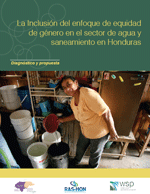 La inclusión del enfoque de equidad de género en el sector de agua y saneamiento en Honduras. Diagnóstico y propuesta.
[
La inclusión del enfoque de equidad de género en el sector de agua y saneamiento en Honduras. Diagnóstico y propuesta.
[
 – 4 MB]
– 4 MB]
World Bank Water and Sanitation Programme Latin America and the Caribbean (WSP-LAC). 2007
This article presents the results and the multi-level findings of the study on the inclusion of gender equity approach within the water and sanitation sector in Honduras. It identifies different elements which could be included in both the sectoral strategies and policies, and the project design levels. The report provides water and sanitation experts, gender experts, public officers, institutions, private organizations, NGOs, bodies and other practitioners, with operative guidelines to develop working tools that include gender equity perspectives in their water and sanitation projects.
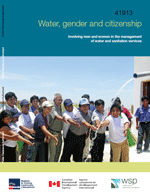 Water, gender and citizenship: involving men and women in the management of water and sanitation services
Water, gender and citizenship: involving men and women in the management of water and sanitation services
[ - 1.44 MB]
- 1.44 MB]
World Bank Water and Sanitation Programme Latin America and the Caribbean (WSP-LAC). 2007
This document attempts to contribute to the debate on how to promote equal relations between men and women in terms of access to, control and benefits of water and sanitation services, on the basis of a concrete experience. The document is based on the experience of the Small Town Pilot Project in Peru (STPP) in promoting inclusive citizen participation, involving both men and women, in decisions on the management of water and sanitation services in localities having between 2,000 and 30,000 inhabitants. It summarizes the lessons learned and aims to identify how including the gender component in all phases of the decision making process contributed to benefits on water, hygiene and sanitation services.
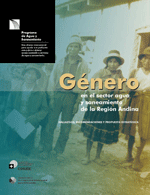 Género en el sector agua y saneamiento de la Región Andina. Hallazgos, Recomendaciones y Propuesta Estratégica
Género en el sector agua y saneamiento de la Región Andina. Hallazgos, Recomendaciones y Propuesta Estratégica
[
 - 1.95 MB]
- 1.95 MB]
World Bank Water and Sanitation Programme Latin America and the Caribbean (WSP-LAC). 2002
This document provides a diagnosis of the gender perspective on water and sanitation in Bolivia and Peru. It presents the gender perspective in the water and sanitation sector at different levels and defines the guidelines for a strategy aimed at effectively including the gender equity component in water and sanitation projects in the region. The document presents main conclusions, results and recommendations and some action lines to develop a gender strategy in the water and sanitation sector.
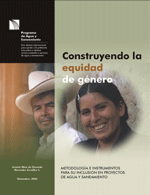 Construyendo la Equidad. Metodología e Instrumentos para su inclusión en Proyectos de Agua y Saneamiento
Construyendo la Equidad. Metodología e Instrumentos para su inclusión en Proyectos de Agua y Saneamiento
[
 - 1.35 MB]
- 1.35 MB]
World Bank Water and Sanitation Programme Latin America and the Caribbean (WSP-LAC). 2002
This document is a guidebook aimed at promoting gender equity in water and sanitation projects. It introduces a methodology and some tools to help mainstreaming the gender equity component in water and sanitation projects based on the the Water and Sanitation Programme framework and experiences from different water and sanitation projects implemented in Peru.
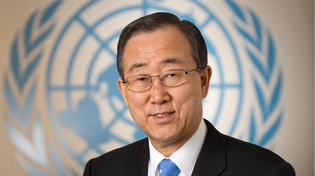
"Water challenges go beyond questions of access. In many countries, girls are forced to drop out of school owing to a lack of sanitation facilities, and women are harassed or assaulted when carrying water or visiting a public toilet."
Ban Ki-moon, UN Secretary General
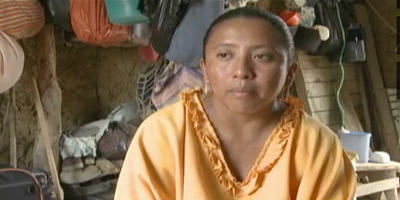
>> Colombia: Wayuu "Gold"
UNTV 21st Century
Place: Colombia
Year: 2011
Duration: 8min46sec
Desert conditions have been exacerbated in recent years in Northern Colombia. The indigenous Wayuu women are struggling to ensure their community's very survival despite dwindling water resources. This video shows the initiatives they have taken to improve the situation.
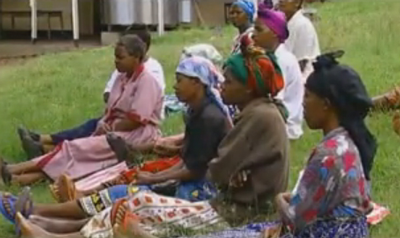
>> Gender Mainstreaming in Water and Sanitation in African Cities
United Nations Human Settlements Programme (UN-Habitat), Gender and Water Alliance
Year: 2010
Duration: 5min31sec
This video highlights the importance of mainstreaming gender in the WASH sector in Africa. It introduces the problems women face every day in relation to water and sanitation.
Copyright | Terms of use | Privacy notice | Site Index | Fraud alert | Help





